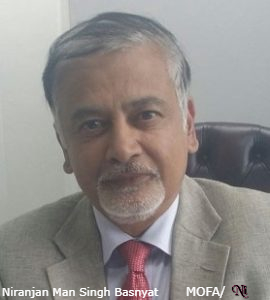“In South Asia, SAARC was made dysfunctional by the rivalry of India and Pakistan whereas both countries sit together in Shanghai Cooperation Organization (SCO) to serve their national interests. Why can’t they sit together in SAARC and move it forward once again? India becomes helpless and complains when China includes a large chunk of their territories in their recent map released on 28 August 2023 (Arunachal Pradesh 90,000 sq. km. and some parts of Aksai Chin). On the other hand India as a big country incorporates small land areas of weak and poor Nepal in their map (Limpiadhura, Lipulek and Kalapani), what a double standard in bilateral relations!!!”
–Excerpt from this article.
______________________________________________________________________________
-Dr. Niranjan Man Singh Basnyat
Kathmandu, Nepal

Background:
The recent international scenario has witnessed many adverse situations including Covid 19 pandemic and Russia-Ukraine war, and also increasing trend of global warming, poverty etc. Climate change has become a burning issue due to depletion of the ozone layer through carbon emissions from excessive numbers of vehicles and other such activities. There were many other challenges such as scarcity of potable water in many parts of the globe during the last two decades. The current situation of international relations is very volatile and fragile. Powerful countries are more inclined towards tussle and conflict thus creating an atmosphere of mistrust and animosity in their relations with other countries.
There is a big divide between developing and developed countries. Global governance and control is slipping from the hands of the US and its allies due to the tremendous rise of China in the fields of economy, technology and military hardware.
It seems that the USA is nervous about the progress China has made particularly in the fields mentioned above.
Furthermore, China is among five permanent members which has nuclear weapons also in its military arsenal.
The United Nations which was established primarily to maintain international peace and security has become more and weaker by the passage of time. It failed recently to stop a large-scale war between Russia and Ukraine. It could not convince Russia and US allies not to escalate the situation prior to 24 February 2022. As we are all aware that Ukraine wanted to become a member of NATO and EU which was promoted by the US and its allies including EU members. Many Eastern European countries became members of NATO. Russia thought that it was pushed to the wall due to such activities. Thereafter, Russia attacked Ukraine. This war has been a major threat to international peace and security recently. The prices of fuel, wheat, rice and other basic food products have risen since February 2022 to a new height which made the life of the people world-wide more difficult. Though the World Trade Organization has been operating since 1995, owing to the many discriminatory policies it has adopted in international trade and industrial production vis-à-vis developing countries including LDC and SIDS, the number of poor people in the world has gone up in these years.
Nuclear Weapons: The Biggest Threat to World Peace:
Today, a total of nine countries possess nuclear weapons. They are: USA, Russia, UK, France, China, India, Pakistan, Israel and North Korea (DPRK). The first five countries are the permanent members of the UN Security Council with the veto power and they have already ratified the Non-Proliferation Treaty (NPT 1970) becoming parties to the Treaty. Other four countries India, Pakistan, Israel and North Korea (DPRK) have not signed and ratified the NPT yet, though they are now nuclear weapon states. Israel has not officially declared yet that it has nuclear weapons but generally it is believed that it possesses several devices. According to Stockholm International Peace Research Institute (SIPRI), which publishes its annual report on the status of nuclear weapons, total global inventory of nuclear weapons is estimated at 12,512 as of January 2023, with approximately 9,576 warheads ready to be used against the potential enemies at any time. Ninety percent of them are in the stockpiles of the US and Russia. 3,844 warheads are on deployment on the ground fitted with missiles in different locations. These weapons are enough to destroy the whole world a thousand times. A total of 2,000 warheads from Russia and the United States are kept with high operational possibilities.
Following are the country-wise stockpiles of nuclear weapons: a. Russia-6257, b. USA-5550, c. China-350, d. France-290, e. U.K.-225, f. Pakistan-165, g. India-156, h. Israel-90 and i. North Korea (DPRK) – 35 to 65.
When we talk about nuclear weapons, we must not forget the fact that several efforts were made by the international community primarily by the United Nations to achieve General and Complete Disarmament after 1945. The first ever resolution no. 1 (1) of the UN was very clear about the complete nuclear disarmament (adopted by the First Committee of the United Nations General Assembly ( UNGA) held in London in 1946).
As recently as in 2017, the most important achievement has been the adoption of resolution on the Treaty on the Prohibitions of Nuclear Weapons (TPNW) by UNGA with the sponsorship of International Coalition for Abolition of Nuclear Weapons (ICAN) and many smaller countries. The 50th instrument of ratification by Honduras which was required by the provision of the Treaty on 24th of October 2020 at the United Nations in New York was a landmark event because the with the 50th country’s ratification, the Treaty was ready for entry into force as an international law. There was a news in the media that the then US President Trump wrote to several Heads of States to not ratify the Treaty. The provisions of the Treaty require that all the nuclear tests be prohibited and the nine countries which have stockpiles of nuclear weapons must negotiate with the United Nations Representatives on the timetables for the dismantling of each and every nuclear device in their arsenal. Till now, 68 countries have ratified this Treaty and Nepal has signed it in 2017. This Treaty has entered into force on 22nd January 2021.
________________________________________________________________________________
The current situation of international relations is very volatile and fragile. Powerful countries are more inclined towards tussle and conflict thus creating an atmosphere of mistrust and animosity in their relations with other countries. There is a big divide between developing and developed countries. Global governance and control is slipping from the hands of the US and its allies due to the tremendous rise of China in the fields of economy, technology and military hardware. It seems that the USA is nervous about the progress China has made particularly in the fields mentioned above.
_______________________________________________________________________
As a peace-loving nation and the land of birthplace of Buddha, it would have been better if Nepal could have ratified within the 50 countries to signal that Nepal is very much in favor of global disarmament and peace, but unfortunately due to tussles among the major political parties, this was not possible to adopt it from the Parliament as yet. It is much more pressing for us to ratify because Nepal is surrounded by three nuclear weapon states; India, Pakistan and China. As the President of Lumbini Research Centre for Understanding and Peace, this writer had reminded the then Prime Minister Deuba for the early ratification of the Treaty through a letter on 14 September 2021.
The TPNW is the only hope for humanity at present to eliminate the deadly and disastrous weapons of mass destruction forever to save human beings from self- annihilation in the possible outbreak of nuclear war. But those countries which possess these weapons are adamant and not ready to abandon them thereby refusing to create a more secured and peaceful world for the succeeding generations. What a double standard in their foreign policy!!!
Poverty and Hunger:
According to an international think tank Focus Economics based in Barcelona, Spain, the top five poorest countries are located in Sub-Saharan Africa. They are: Somalia, South Sudan, Sierra Leone, Malawi and Central African Republic. The per capita GDP forecast for the year 2026 is US$ 303 for Somalia, US$ 441 for South Sudan, US$ 532 for Sierra Leone, US$ 606 for Malawi and US$ 624 for Central African Republic. Nepal’s per capita GDP for 2021 was US$ 1184. These data show how poor these countries are in the 21st century.
The Covid-19 pandemic, inflation, conflict and climate change are estimated to have slowed down and, but in many cases, reversed the course towards poverty eradication, putting the goal to end extreme poverty by 2030 unachievable. For the poor countries, globalization also squeezed their weak economies further and made them worse. The World Bank estimates for 2022 indicate that poverty rates have likely returned to 2019 levels, with about 682 million people (8.5% of the world population) living in extreme poverty. In 2022, we estimate that 1.85 billion people (26% of the global population) lived below the threshold of $3.65 a day and 3.71 billion (46% of the global population) lived below the threshold of $6.85 a day. Nepal is being compared with Haiti and Afghanistan in terms of poverty level. Nepal is one of the poorest countries of the world though it aspires to graduating from its status of an LDC to a developing country in 2026.

The UN has a very ambitious target of eliminating poverty by 2030 which is mentioned in its first Sustainable Development Goal (SDG 1: “End poverty in all its forms everywhere”). It is a multi-dimensional problem and it needs a multi- dimensional policy approach to alleviate it. This Goal to eliminate poverty complements 16 other SDGs.
According to FAO, at the end of 2021, around 193 million people suffered from acute hunger. The FAO further estimates that “there are 2.3 billion people facing less extreme, but still dangerous, levels of food insecurity. That’s roughly 29% of the global population.”
There are other problems like gender discrimination, religious conflicts, and human rights violations, refugees and IDPs, child malnutrition, elderly population, acute shortage of potable water, corruption and organized crimes etc.
Flashpoints:
There are many flash points in the present-day world from where a large-scale war or a Third Great War can emerge. Apart from the Russia-Ukraine war which is continuing, the policy adopted by the US through its Indo-Pacific Strategy (IPS) in the South China Sea, East Asia Sea, Korean Peninsula (particularly the threat of North Korea to use nuclear weapons) and covering other strategic areas of the Asia and Pacific region may pose danger to China and if that would be the case, it is likely to react militarily. On the other hand China is strengthening its military and its related technology. The recent sale of US$ 50 billion worth of military aircrafts and their accessories by the US to Taiwan, and US and UK’s plan to arm Australian submarines with nuclear heads by the year 2036 would be posing serious threats to world peace. Besides these threats, long standing Israeli -Palestinian Conflict, India-Pakistan Rivalry and China-India Border Hostilities are other flashpoints from where a full-scale war can trigger at any time. Iran’s ambition to acquire nuclear weapons is causing problems to the US, Arab countries and Israel in West Asia. In South Asia, SAARC was made dysfunctional by the rivalry of India and Pakistan whereas both countries sit together in Shanghai Cooperation Organization (SCO) to serve their national interests. Why can’t they sit together in SAARC and move it forward once again? India becomes helpless and complains when China includes a large chunk of their territories in their recent map released on 28 August 2023 (Arunachal Pradesh 90,000 sq. km. and some parts of Aksai Chin). On the other hand India as a big country incorporates small land areas of weak and poor Nepal in their map (Limpiadhura, Lipulek and Kalapani), what a double standard in bilateral relations!!!
In Nepal, MCC projects and BRI projects are being implemented soon but there is a danger of coming face to face between two giants i. e. the US and China. Many experts have predicted that there is a possibility of conflict between the US and China in Nepal’s soil. Thus it may create a situation as that of Afghanistan for us.___________________________________________________________________________
“There are many flash points in the present-day world from where a large-scale war or a Third Great War can emerge. Apart from the Russia-Ukraine war which is continuing, the policy adopted by the US through its Indo-Pacific Strategy (IPS) in the South China Sea, East Asia Sea, Korean Peninsula (particularly the threat of North Korea to use nuclear weapons) and covering other strategic areas of the Asia and Pacific region may pose danger to China and if that would be the case, it is likely to react militarily.”
_______________________________________________________________________________
Climate Change Issues and Rise of Population:
The recent data on climate change indicates that there is an alarming situation facing this earth. Global warming has increased with the rise of one degree Celsius every year. In Nepalese mountains, it even surpassed at the increased rate of 1.5 degree Celsius. It has decreased the productivity in agriculture in the mountains as well as triggered many weather disasters such as flash floods, landslides and cyclones etc. Water sources are drying up in many countries including in Nepal. The “polluters pay” principle needs to be applied strictly at the international level.
According to an estimate, the world’s 10 percent rich countries are responsible for 50 percent of Greenhouse Gas (GHG) emissions. Those who are least responsible for pollution should not be punished at the same rate as these rich countries.
Biggest polluters must reduce their carbon emissions and contribute to amelioration of world climate and environment. Nepal is suffering from the melting of snow at the high rate in the Himalayas, rightly called the Third Pole, thus contributing to the world’s climate change. In this writer’s opinion, climate change is not a local problem only but it has a global dimension, so it must be tackled at the international level with adequate resources.
Following is a list of biggest polluters of the world (2019):
1 China, with more than 10,065 million tons of CO2 released.
2 United States, with 5,416 million tons of CO2
3 India, with 2,654 million tons of CO2
4 Russia, with 1,711 million tons of CO2
5 Japan, 1,162 million tons of CO2
6 Germany, 759 million tons of CO2
7 Iran, 720 million tons of CO2
8 South Korea, 659 million tons of CO2
9 Saudi Arabia, 621 million tons of CO2
10 Indonesia, 615 million tons of CO2
From above, it is estimated that every year more than 30 giga-tons of CO2 are released into the Earth’s atmosphere, which is the main cause of the greenhouse gas effects that contribute to climate change.
In this context, the rich developed countries should also support countries like Nepal (sandwiched between the first biggest polluter China and the third biggest polluter India) in their efforts to mitigate the pollution and improve their environment.

Another problem facing the globe is the increase in the world’s population. It is increasing at the rate of 0.83 percent annually. The current population is 8.1 billion.
Recently the population of India has surpassed the population of China.
We all know that Nepal is located between these two big countries and it may cause population problems if we do not control the influx of people such as refugees and poor people from other countries into our country. The continuous increase in population is one of the major reasons for pollution in the world. High rate of Desertification and deforestation at the massive scale, and human encroachment to the habitat of wild animals are also other major concerns. The COP 28 of Climate Change Conference which is scheduled to be held from 30 November to 12 December 2023 in UAE must discuss the entire issues of climate change and assist developing countries with a concrete plan of action.
Conclusion:
In view of the above, the world is faced with a lot of acute problems and extreme situations. Most of them are man-made and can be resolved by human beings themselves. We need to handover this planet to the next generations in a better condition. It seems that it is difficult to happen. Situation has become worse every day. But we need not be very pessimistic but we should face every problem with a positive mindset. World peace is possible when we tackle every grave situation one by one, thus saving the future of homo-sapiens on this planet.
End text.
# Dr. Basnyat is a former Ambassador and the current President of Lumbini Research
Centre for Understanding and Peace: Ed. Upadhyaya. N. P.
# The Opinions expressed here are those of the author.
# Text courtesy: Shanti Smarika 2080, Peace Souvenir.
